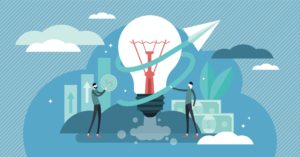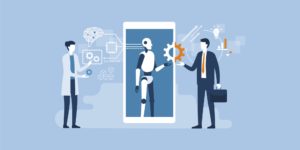When you have several forces of innovation pointing to the same area, there is a good likelihood that disruption will occur.
I learned that lesson during the smartphone revolution when I was COO of Cingular Wireless, and later CEO of AT&T Mobility.
That revolution started with the launch of one device, the iPhone. But major disruption was caused when three innovations converged at the same time on a global scale: the smartphone, mobile applications, and the deployment of broadband wireless networks.
Together, they created an environment that made it possible for companies like Uber and Airbnb to implement, on a global basis, innovative business models that would not have been possible otherwise.
A repeating pattern
As I reflect on that lesson and try to apply it to oncoming trends, I seems to me that similar patterns are unfolding with the potential to impact other established industries.
Take the automobile transportation industry, just as an example.
Three innovations in that area have been picking up speed: battery-operated electric vehicles, ridesharing services, and autonomous vehicles.
Electronic vehicles have been around for a while but penetration is still relatively low. As of 2018, they accounted for 2.2% of cars on the road, perhaps due to the newness of the technology and the performance of their current batteries. However, major advancements are being made to extend battery range (the number of miles it can cover between charges) and battery life (the number of times the battery can be recharged before degrading).
Just this month Tesla announced ranges of 325 and 370 miles for some of its vehicles. Others will surely follow. And when it comes to battery life, research shows that car batteries lasting one million miles may be possible. That’s far more than the current estimate of 200,000 miles, an indication of the speed of innovation in that area.
A 1-million-mile battery may not be a major selling point for individual electric vehicle buyers; they probably don’t plan to own a car that long, anyway. But it’s a major consideration for rideshare companies.
Indeed, companies like Uber, themselves the product of an earlier disruption, are becomingthe second force in this scenario. They are building their electric-vehicle fleets and preparing for the time when autonomous vehicles will receive regulatory approval to operate.
Which takes me to the third force, autonomous vehicles. That technology also has been picking up speed, with developers lining up for testing and approval to operate commercially. Just this month California announced it will allow testing and commercial use of light-duty autonomous delivery vehicles on the state’s public roads.
The rideshare age
According to James Arbib and Tony Seba, authors of Rethinking Transportation 2020-2030, the convergence of these three forces will make way for a new disruptive business model that can completely change the way we move about.
They predict that “By 2030, within 10 years of regulatory approval of autonomous vehicles (AVs), 95% of U.S. passenger miles traveled will be served by on-demand autonomous electric vehicles owned by fleets, not individuals, in a new business model we call ‘transport-as-a-service’ (TaaS).”
In other words, they believe that at some point in the near future, people will find ridesharing services easier and more economical than owning an asset that sits idle 95% of the time.
Could this be possible?
There is another lesson to be learned from past disruption: don’t let small penetration numbers mislead you. In 2006, smartphone penetration was at about 3%, close to where electric vehicles are today. Ten years later, smartphone penetration was at 81%. I’m not here to predict what the penetration of electronic and autonomous vehicles will be 10 years from now. I am offering just a note for us to keep in mind the possible acceleration of innovations once they follow an S-curve trajectory.
New technologies always raise concerns. Unlike with the development of the smartphone, these transportation technologies present additional safety concerns that will need to be addressed prior to their acceptance and approval.
As I said in an earlier article, manufacturers, regulators, and stakeholders must work together to arrive at solutions that make everyone feel comfortable and safe.
The ripple effect of disruption
Another lesson from past innovation is the resulting ripple effect on related industries.
If you believe that the car of the future will be electric and autonomous and that “transport as a service” business model is implemented successfully, then you’ll want to consider what happens next.
When people find they no longer need to own a car, they will not need car insurance. They won’t need a 2- or 3-car garage, either, or even a garage at all. Homes may become more affordable. Airports, shopping centers, and sports arenas won’t need as much parking space (they are already shrinking given the growing popularity of rideshare services). That could free up a tremendous amount of real estate. It will free people from focused driving time, giving them time to read, watch videos, or work instead. And, there may be positive environmental impacts to this scenario, as well.
Opportunity ahead
Disruption is a great teacher. You learn a lot by going through a time when virtually everything you know is turned upside down, and new technologies and ways of doing things emerge.
It also teaches you to keep an eye out for future new trends forming in the horizon, be it in your industry or another.
As leaders, you must be constantly keeping an eye for innovation anywhere. Even if you see a trend not directly related to your industry, remember the lesson I mentioned about the ripple effect of disruption. It may end up impacting your business down the road.
I always say that turbulent times—and disruption certainly qualifies—create opportunity for those who can see through the initial chaos, spot emerging opportunities, and seize them.
The trick is to connect the dots before others do.



